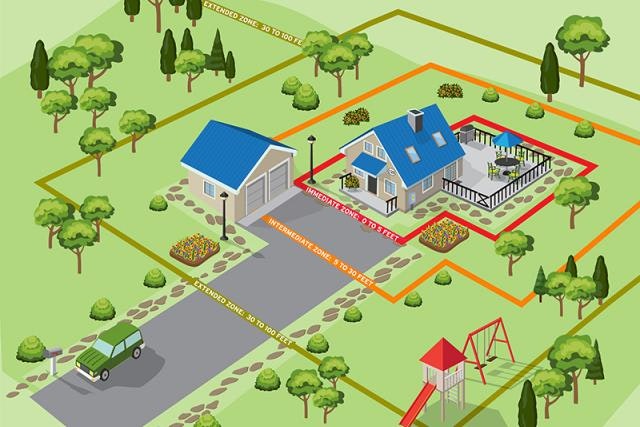Actions to improve your defensible space
The following is a list of actions you can take around your home or business for little to no cost to improve a structures chance of surviving a wildfire event.
Immediate Zone (0-5 feet from the furthest attached exterior point of the home). Research shows that this is the most important zone to take immediate action on as it is the most vulnerable to embers.
-Clean roofs and gutters of dead leaves, debris and pine needs that could catch embers.
-Replace or repair any loose or missing shingles or roof tiles to prevent ember penetration.
-Reduce embers that could pass through vents in the eaves by installing 1/8 inch metal mesh screening.
-Repair or replace damaged or loose window screens and any broken windows. Screen or box-in areas below patios and decks with wire mesh to prevent debirs and combustible materials from accumulating.
-Move any flammable material away from wall exteriors-mulch, flammable plans, leaves and needles, firewood piles-anything that can burn. Remove anything stored underneath decks or porches.
Intermediate Zone (5-30 feet from the furthers exterior point of the home)
-Clear vegetation from under large stationary propane tanks.
-Create fuel breaks with driveways, walkways/paths, patios and decks.
-Keep lawns and native grasses mowed to height of four inches.
-Remove ladder fuels (vegetation under trees) so a surface fire cannot reach the crowns. Prune trees up to six to ten feet from the ground; for shorter trees do not exceed 1/3 of the overall tree height.
-Space trees to have a minimum of eighteen feet between crowns with the distance increasing with the percentage of slope.
-Tree placement should be planned to ensure the mature canopy is no closer than ten feet to the edge of the structure.
-Tree and shrubs in this zone should be lmited to small clusters of a few each to break up continuity of the vegetation across the landscape.
Extended Zone (3-100 feet, out to 200 feet from the home)
-Dispose of heavy accumulations of ground litter/debris.
-Remove dead plant and tree material.
-Remove small conifers growing between mature trees.
-Remove vegetation adjacent to storage sheds or tother outbuildings within this area.
-Trees 30 to 60 feet from the home should have at least 12 feet between canopy tops.
-Trees 60 to 100 feet from the home hsould have at least 6 feet between the canopy tops.
